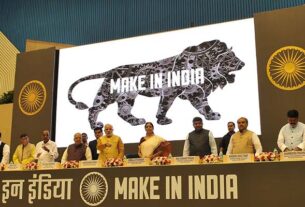Prospects and opportunities in Indian defence industry
As India’s geopolitical interests are expanding in Asia and Africa, the NDA government headed by Prime Minister is giving emphasis to faster modernization of Indian Armed Forces and indigenous development of defence technology.
For PM Modi, who has launched ‘Make in India’ campaign for both civilian and defence sector, the primary objective for civilian sector is to create jobs while for Indian defence sector he is giving emphasis to new generation military technologies.
Although India’s arms import is falling by small percentage, its dependence on new generation technology is growing due to lack of research and development in acquiring state of the art technology for its military forces.
Of late, India’s new leadership has realized that without a strong military it will not be able to ensure its geopolitical interest across the region to sustain a strong economic growth.
Since independence, India has been trying to establish a strong military industrial complex (MIC) but it has rarely got any success story to tell due to excessive government control over defence production.
Though the Indian defence industry has evolved and has been developing capabilities in land, naval and air systems, India continues to import over 70% of its defence equipment, a situation which is neither acceptable from a security nor financial point of view. The ambition to develop an indigenous Indian defence industry has been given increased prominence in the recent past and highlighted in policy statements by the new government. It has been emphasized that both the Indian public and private sectors should play a larger role in producing state-of-the-art equipment for the Indian forces.
With the government’s decision to raise the foreign direct investment limit from 26 percent to 49 percent in the defence sector, the country is likely to witness the next rush of investments. India continues to be one of the promising aerospace and defence (A&D) markets in the world due to the increasing demand in A&D equipment for the armed forces. The Indian defence manufacturing sector is internationally competitive with international quality standards, efficiency and manufacturing facilities. India is fast developing into a manufacturing hub for global corporations willing to leverage the sector’s proven skills in product design, reconfiguration and customization with creativity, assured quality and value addition.
Defence manufacturing
In order to boost domestic manufacturing, the department of industrial policy & promotion (DIPP) has recently prepared a draft Cabinet note that proposes to allow up to 100 per cent FDI in defence with three caps, 49 per cent, 75 per cent and 100 per cent.
In case of no technology transfer, the cap is 49 per cent FDI, while in case of technology transfer the cap is 74 per cent. The department has proposed that the no-cap policy be reserved for cases which bring in state-of-the-art technology.
The new Indian government is determined to focus on indigenization with increasing presence of Indian companies and also giving cost advantages relating to basic design and engineering services, components, and assemblies manufacturing. Indian companies will likely succeed with the help of foreign companies, which creates a benefit for both. Once indigenous manufacturing takes root, research and development for the indigenous military industry and civil aircraft is likely to be the other focus area of the Indian government.
However, it will take time for the NDA government to repair the damage caused to the defence forces modernization by the inefficiency of the previous UPA government which lacked the decision making capability. For the Indian armed forces, military modernization was perhaps the biggest casualty under the previous UPA-led government. From numerous procurement scandals to the inability of the government to foster indigenization of research and development, the nation’s defence preparedness was at its worst. But to establish a solid military-industrial base and fast-track indigenization, the new BJP led government needs to have a long-term plan, to guide development. However the ‘Make in India’ campaign has given hopes to global defence manufacturers. A key feature of Modi’s government’s defence strategy is to indigenously develop military equipment as part of its broad ‘Make in India’ strategy-the decision to build six submarines in India at a cost of about Rs 50,000 crore is a clear deviation from the hitherto followed strategy of sourcing military equipment from outside.
With this approach India will be benefitted in long run and will be able to acquire new military technology which is important in maintaining strong armed forces in the changing battlefield scenario. According to recent reports India is likely to be among the top three military powers in the world by 2045, along with the US and China, with a projected defence outlay of $654 billion. It is also likely to surpass Japan, Australia and South Korea by developing sizeable and technically advanced armed forces, including ocean-going navies, capable of delivering an enduring and capable maritime presence both regionally and further afield.
India enjoys the peculiar distinction of being both a sizable arms-producing state as well as a large consumer of imported weaponry. Its demand for advanced weaponry-which its indigenous defence industry is as yet unable to fulfill-has resulted in a boon for foreign arms producers, especially Russia, Israel, and the United States.
While the US will continue to be a key partner in India’s quest to emerge a global military power, as reflected by the Modi government’s recent decision to acquire Boeing’s Chinook and Apache helicopters in a deal worth $2.5 billion, what is more important is India’s growing defence alliance with Israel. The fact India chose to buy anti-tank guided missiles worth $670 million from Israel, rejecting a rival US offer to co-develop and co-produce US’ Javelin missiles in India, reinforces that Israel is likely to be a crucial defence ally for India going ahead.
Meanwhile, India and Russia are also putting efforts to re-affirm their commitment to the long standing friendship and cooperation in the area of Defence Cooperation. Defence Ministers of both the countries in a recent meeting discussed possible future areas of cooperation in high technology defence platforms as well as armament for the three Services.
The Make-in-India initiative of the government is focused on 25 sectors that include defence manufacturing. India’s current requirements on defence are catered largely by imports. The opening of the strategic defence sector for private sector participation will help foreign original equipment manufacturers to enter into strategic partnerships with Indian companies and leverage the domestic markets and also aim at global business. Besides helping build domestic capabilities, this will bolster exports in the long term.
The government is putting efforts to implement policy of promoting self-reliance, indigenization, and technology upgradation and achieving economies of scale and developing capabilities for exports in the defence sector. The country’s extensive modernization plans, an increased focus on homeland security and India’s growing attractiveness as a defence sourcing hub can be a big attraction for foreign investments in defence sector.
For sure, the change in government-widely seen as investor-friendly, decisive and keen to improve the system-is an important factor. The government seems determined to make it easier to do business in India. Since it came to power in May 2014, the new government has taken three steps that have a bearing on defence manufacturing. A list of defence items requiring industrial license was notified in June 2014. A security manual for licensed defence industries was also notified the same month. In August, the FDI cap for the defence sector was increased to 49% with a provision that even higher FDI could be permitted if it provided access to state-of-the-art technology. These are welcome steps.
Private sector
Indian private sector companies are making inroads in the defence equipment market-both globally and locally. For long considered a set of obscure contractors making small parts, Indian manufacturers are coming of age.
Giving a push to the Make in India drive, the government recently cleared 19 defence proposals of various companies including Punj Lloyd and Bharat Forge that had been pending for the last few years.
This is a result of the policy change by the BJP government, which allowed more than one Indian company to hold a cumulative 51% share to encourage more domestic players in the sector. Earlier, it was mandatory for a single Indian company to own and control the company.
Applications for defence production from major companies such as Reliance Aerospace Technologies, Bharat Forge, Mahindra Telephonic Integrated Systems, Punj Lloyd Industries Limited, Mahindra Aero Structure and Tata Advanced Materials were approved. In the case of another 14 pending defence applications, the companies were informed that licences were not required anymore as a vast number of defence items have been delicensed. The government reduced the items requiring industrial licences by about 60% last year.
Dual-use items, having military as well as civilian applications, now do not require industrial licences from the defence angle. The FDI limit in defence was raised to 49% to address large imports by indigenizing production. India is one of the largest defence importers in the world.
The MoD also has requested proposals from eight foreign vendors for 56 medium transport aircraft to replace the Indian Air Force’s ageing fleet of HS 748 Avros. What is striking about the deal is not its value of around Rs 28,000 crore, but the fact that the ministry has deliberately kept the state-owned Hindustan Aeronautics Ltd away from the competition.
This is the first time in recent decades that the government has consciously chosen to open up a military industrial contract to the private sector. These are only tiny steps in the right direction.
While other sectors of the manufacturing industry in the country, notably automobiles, have become world class sectors, the record of government-run arms industry remains one of failure and disappointment. It is better not to discuss about the performance of the Ordnance factories and Defence Public Sector Units (DPSUs). Evidence suggests that DPSU have actually been going out of their way to serve the interests of the foreign “partner,” rather than the PSU they head.
Domestic defence manufacturing is dominated by defence public sector undertakings (DPSU) and Ordnance Factories Board (OFB), which together have an 80-90% share of domestic defence manufacturing. However, various private sector companies have been involved in a small way with several defence projects over the past years. Larsen & Toubro, the Tata group, Pipavav Defence and Offshore Engineering Ltd, among others, have tied up with global defence companies and have created infrastructure required to take on bigger roles in the defence space. Even Mukesh Ambani-controlled RIL has been nurturing its ambitions in the defence space over the past few years and is likely to enter the aerospace business with several tie-ups in place.
The Indian defence sector will be a significant opportunity for both foreign and domestic players, given the government’s intent to promote the domestic defence industry via a fresh dose of defence reforms.
The private sector is enthusiastic about its ability to play a larger role in contributing to the total defence related production both within the country, as well as looking at export markets once sufficient experience has been gained in particular areas. The need of the hour is to combine the skills of Public and Private sector, developing this into a partnership with the aim of achieving self-reliance in defence production.
In defence contracting, there are three distinct phases of manufacturing. The first, “build-to-print”, is the most basic capability. Here contractors manufacture according to designs provided by an external client. In 2010, 92 per cent of the private sector’s order inflow in India was build-to-print, which requires the least technical proficiency. In 2014, experts estimate it to have shrunk to about 80 per cent of the orders.
The second, “build to specifications”, is where the executor of the project can own intellectual property. Here, the client comes with an idea of a product, and asks the executor if it can be manufactured. Often, these products require developing new intellectual property that may belong to the Indian contractor. The third part is developing products from scratch, either to create new capabilities for a particular defence need or upgrade an existing product. Indian manufacturers have now started building capabilities in the second phase.
Various governments worldwide have adopted different strategies to determine the role of the private sector in the defence industry. Although in many countries, the government continues to dominate the sector primarily driven by the sensitive nature of the industry. The private sector plays a significant role in the United States defence sector. US companies play a major role in the global defence industry with various countries relying on them for a majority of their imports. US companies such as Boeing, Lockheed Martin and Northrop Grumman form a substantial contributor to the defence imports made by many countries in the world.
In terms of market share, the Indian private sector is still emerging compared to the private sector in other developed nations. Foreign companies account for the majority of procurement from the private sector in India, with approximately 70 percent of Indian defence procurement coming from overseas sources. Of the 30 percent of orders placed in India, only an estimated 9 percent is attributed directly to the private sector.
However, major Indian industrial houses like the TATA Group, Mahindra Group, the Kirloskar Brothers and Larsen and Toubro have diversified in to the defence sector, forming joint ventures with foreign companies on both strategic and product specific bases.
A large number of micro, small and medium-size enterprises (MSMEs) also operate within the Indian defence industry, providing components to the DPSUs and large private players.
With Prime Minister Narendra Modi’s push to reduce import dependence in defence equipment, India’s likely defence outlay is estimated at $248 billion over the next 10 years. The Indian Government also has aspirations to significantly enhance indigenous production capabilities (particularly in relation to advanced technologies). This would represent a shift from historical patterns of defence procurement, which have typically involved foreign supply of critical components, with some licensed indigenous production. Supporting this objective, and in keeping with broader moves to open up the Indian economy, the Ministry of Defence has implemented a series of changes to the governance and planning processes for defence acquisitions to improve the transparency of long term defence acquisition plans to the private sector.
Foreign companies
India is seeking to acquire some of the most globally advanced platforms and systems for its Navy, Army and Air Force. India is also seeking to acquire sophisticated defence electronics and communications systems, including the intention to equip infantry soldiers with advanced equipment under the Future Infantry Soldier as a System project. Clearly an expansion such as this offers considerable opportunities to the international defence industry, including foreign companies.
While India has a stated goal to transition to a higher proportion of indigenous production, the private defence industry in India is relatively immature, compared to the size of the defence force’s budget and comparable industries worldwide.
The future growth of the defence industry will continue to face barriers to growth because of the high infrastructure and investment costs that necessarily accompany state of the art development and manufacturing of defence equipment.
As a consequence, reliance on imports is still expected to continue, particularly where the equipment has a high level of technology sophistication. It would be expected that even if indigenous procurements are able to be increased as a percentage of the defence budget, the absolute amount spent on imports of equipment will still grow as the growth in capital expenditure holds up imports, creating potentially significant opportunities for foreign defence exporters.
However foreign firms do face some challenges while doing business in India, but with the new government they are hopeful for a brighter future and have started showing positive signs of investment under Make in India campaign.
Russia, Israel, and the United States are currently India’s largest foreign arms suppliers, accounting for nearly 90 per cent of all Indian arms imports for the period 2009-2013. Russian weapons exports made up around 75 per cent of these sales, and include fighter jets, main battle tanks, missile systems, surface combatants, submarines, and even an aircraft carrier. In addition, some of the most advanced armaments coming out of Indian defence factories are licensed-produced versions of Russian weapons systems.
For its part, Israel is a critical supplier of high-tech systems, particularly unmanned aerial vehicles (UAVs) and armed drones, air-defence systems, communication equipments sensors and electro optics, and airborne early-warning radar. The United States is a relative latecomer to the Indian arms market, but a few big-ticket deals, including P-8 maritime patrol aircraft and C-17 and C-130 transport planes, have catapulted it into the top ranks.
Europe’s leading weapons manufacturers, meanwhile, have largely been left out of this Indian arms bonanza, securing only a handful of arms transfer agreements with India in the past decade. European arms producers are now also determined to break back into the lucrative Indian arms market. Rather than straightforward off-the-shelf arms sales, European defence firms appear to be pursuing more innovative ways to get back into business with the India; in this regard, they are taking advantage of recent efforts and initiatives on the part of the Indians to reform and revitalize their arms manufacturing and acquisition processes-in particular, expanding the role that foreign firms can play in indigenous arms manufacturing, and opening up the defence manufacturing sector to private Indian firms.
India is encouraging foreign defence firms to form long-term and comprehensive cooperative relationships with local arms producers, i.e., by permitting foreign firms to invest in India’s defence industry, by promoting joint R&D and coproduction, and by formalising offsets and leveraging them for technology acquisition.
The Indian government is attempting to expand the process of foreign-local armaments collaboration in ways that go far beyond previous dealings. In the past, most defence-industrial cooperation revolved around one-way technology transfers from the supplier-country to India, usually in the form of licensed-production arrangements. Today, India is looking for strategic-that is, deeper, broader, more formal, and (hopefully) more permanent-collaboration with foreign defence firms. In particular, it is seeking true partnerships in the form of cooperative relationships in which Indian defence companies can play an active, vital role in the joint development, production, and even marketing of new weapons systems.
India’s military development woes are a collective problem, encompassing almost a decade of mismanagement, structural limitations, bad decisions, and obsolete policies. However foreign firms do face some challenges while operating in India and they desire to see few successful changes in the government defence procurement process. Many firms look for greater transparency, simplification and acceleration of processes, and more open dialogue and collaboration.
As India plans to acquire defence equipments worth $100 billion during the next decade, the foreign defence firms have entered into dialogues with Indian private sector companies for setting up joint ventures on Indian soil.
Some more factors that are likely to influence the future growth trajectory of the defence sector in India are: further development of the defence procurement process; the formation and implementation of a defence industrialization strategy to coordinate the use of offsets, transfer of technology, FDI and the public and private sector defence industries in India; and further changes to the taxation regime and incentives. This offers considerable opportunities to the international defence industry, including foreign companies.
The challenge in India is to build domestic capability, which would be fully based on cutting edge technology. The process requires Indian public and private sector defence companies to develop technologies and start designing and producing state-of-the-art systems in the immediate future. Indian private defence industry will require significant investment into R&D, infrastructure and production facility to be able to meet the goals of the Indian armed forces modernization and cooperation with foreign defence firms can be beneficial to acquire new generation technology, which is the need of the hour.




